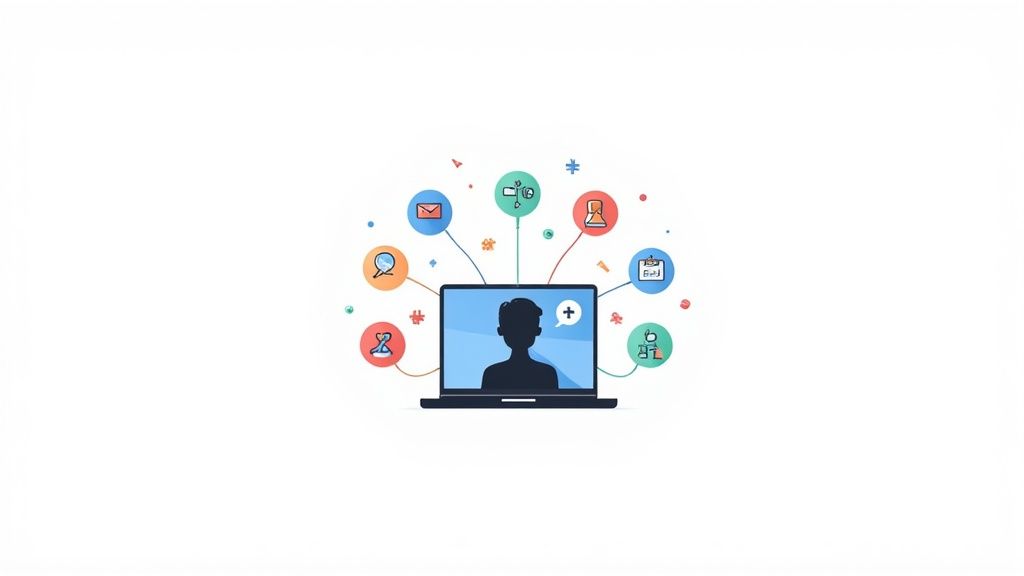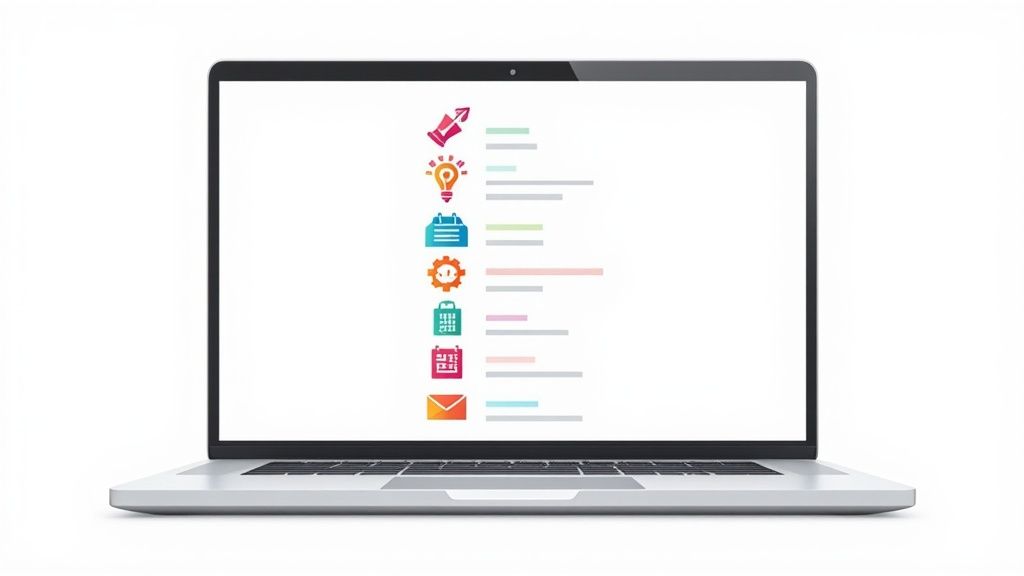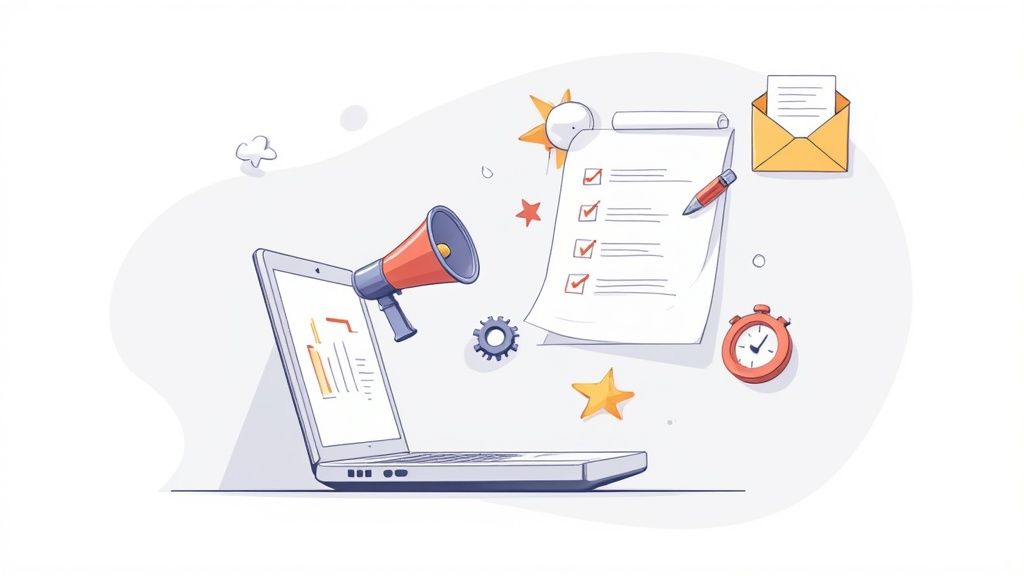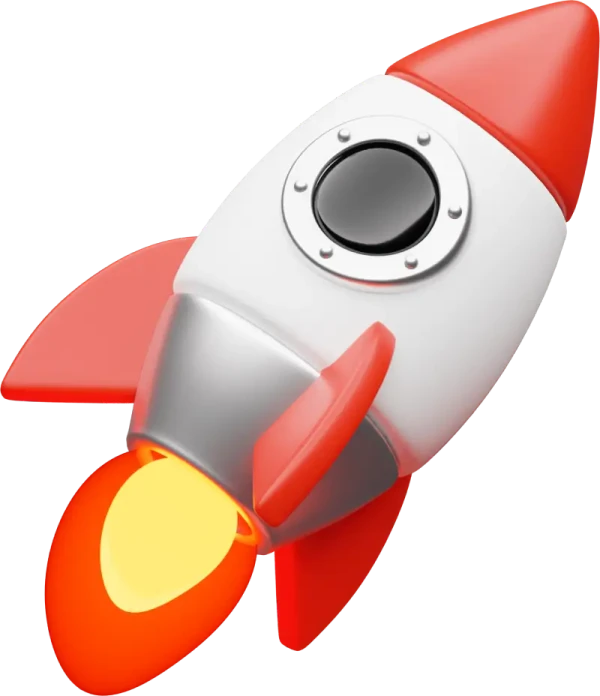In 2025, simply hosting a webinar is not enough. The digital space is crowded, and your audience demands more than just a slideshow with a voiceover. To succeed, you need sophisticated webinar marketing strategies that cut through the noise, captivate your audience from the first touchpoint, and turn attendees into loyal customers. It's about creating an entire experience, from the initial invitation to the post-event follow-up. This involves a multi-faceted approach covering promotion, live engagement, and nurturing leads afterward.
A critical, yet often overlooked, part of this process is ensuring your event actually makes it onto your audience's calendar. Tools like Add to Calendar PRO are essential here, seamlessly integrating into your landing pages and emails to boost show-up rates by making it effortless for registrants to remember your event. A high registration count means little if nobody attends.
In this comprehensive guide, we will explore nine proven strategies that transform your webinars from simple online presentations into powerful marketing engines. Each strategy is designed to be actionable, providing you with the framework to not only attract more registrants but to create unforgettable virtual events that drive measurable results. Let's move beyond the broadcast.
1. Educational Content First Strategy
One of the most effective webinar marketing strategies is to prioritize genuine educational value over a direct sales pitch. The Educational Content First Strategy dedicates the vast majority of your presentation, typically 80-90%, to teaching your audience valuable concepts, actionable techniques, or crucial industry insights. The remaining 10-20% is reserved for a brief, relevant mention of your product or service as a solution to the problems discussed.

This approach, popularized by thought leaders like Neil Patel and organizations like HubSpot Academy, works because it builds a foundation of trust. By delivering on your promise of education, you position your brand as a credible authority and a helpful resource. Attendees who gain real value are more receptive to your offer when it's presented as the logical next step.
How to Implement This Strategy
- Identify Core Pain Points: Begin by researching your target audience's most significant challenges. Use surveys, social media listening, and keyword research to discover what problems they are actively trying to solve.
- Structure Your Content: Create a detailed, step-by-step tutorial or a deep dive into a complex topic. Structure your webinar to guide attendees from a problem to a solution, with your product being a tool to help them implement that solution.
- Provide Tangible Resources: Enhance the educational experience by offering downloadable resources. This can include checklists, templates, worksheets, or detailed guides that attendees can use long after the webinar ends.
- Tell a Compelling Story: Use storytelling to make abstract concepts memorable and relatable. Share a case study or a personal experience that illustrates the principles you are teaching.
This method is ideal for businesses in knowledge-based industries or those with complex products. It excels at attracting top-of-funnel leads and nurturing them into loyal customers by demonstrating expertise and generosity upfront.
2. Product Demo and Behind-the-Scenes Strategy
A highly effective webinar marketing strategy for mid-funnel and bottom-funnel audiences is the live product demonstration. This approach shifts from pure education to showcasing your product or service as the direct solution to a known problem. It provides an insider's view, guiding attendees through features, real-time problem-solving, and offering a transparent look at your company's operations.
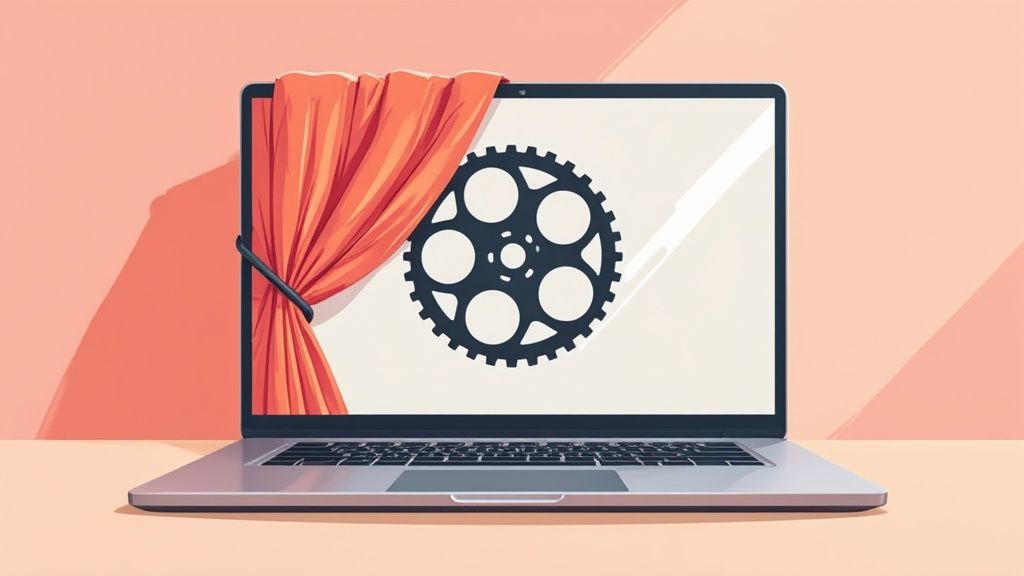
Pioneered by SaaS giants like Salesforce and Adobe, this strategy works by directly addressing the question, "How can your product help me?" Instead of telling, you are showing. Seeing the product in action builds confidence, answers specific user questions, and shortens the sales cycle by allowing qualified leads to self-select and make informed purchasing decisions.
How to Implement This Strategy
- Focus on Benefits, Not Just Features: Frame your walkthrough around a specific outcome. Instead of saying "Here's our dashboard," say "Here's how you can launch a campaign in under five minutes."
- Prepare for Technical Glitches: Thoroughly test every aspect of your tech stack, from your webinar platform to your demo environment. Always have a backup plan, like pre-recorded video clips of key functionality, in case of live issues.
- Incorporate Customer Use Cases: Integrate testimonials or brief case studies to illustrate how real customers use the features you are demonstrating. This adds powerful social proof and makes the benefits more tangible for your audience.
- Offer an Exclusive Bonus: Encourage immediate action by providing a time-sensitive offer exclusively for live attendees. This could be a special discount, an extended trial, or a valuable bonus package unavailable elsewhere.
This method is perfect for SaaS companies or businesses with tangible products. It excels at converting interested prospects into paying customers by clearly demonstrating value and creating a sense of urgency.
3. Expert Interview and Panel Discussion Strategy
Leveraging the authority of others is a powerful webinar marketing strategy. The Expert Interview and Panel Discussion Strategy involves featuring industry experts, influential thought leaders, or successful customers to share their unique perspectives and experiences. This format shifts the focus from your brand to a collaborative conversation, providing immense value through diverse insights.
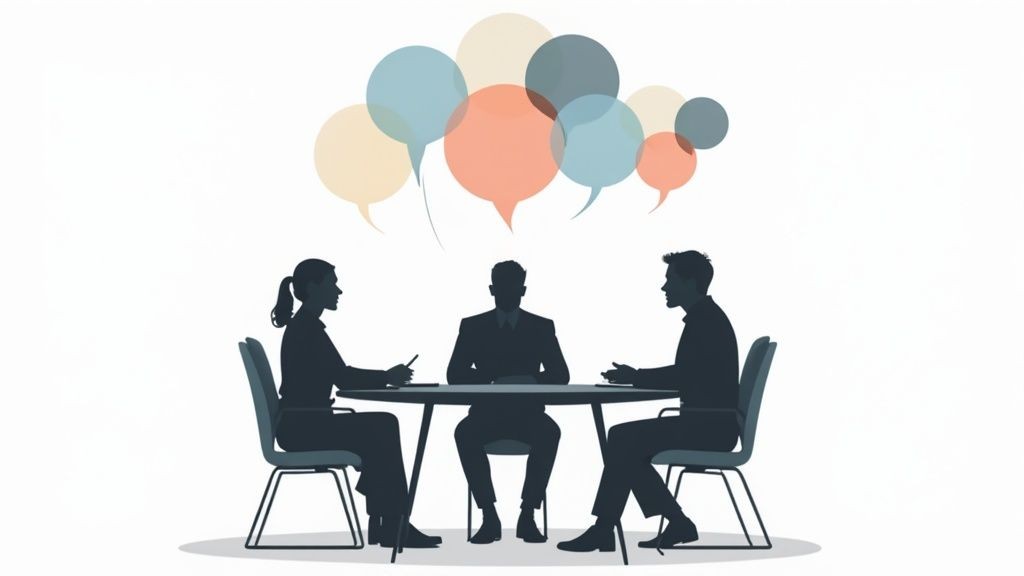
This approach, championed by figures like Michael Stelzner of Social Media Examiner and Amy Porterfield, builds credibility by association. When you host respected voices, their authority transfers to your brand. Furthermore, each guest promotes the event to their own network, exponentially expanding your promotional reach and attracting a highly relevant, pre-qualified audience.
How to Implement This Strategy
- Choose Strategic Guests: Select experts or customers whose audience demographics align perfectly with your target market. Their relevance is more important than their follower count.
- Prepare Insightful Questions: Develop thoughtful, open-ended questions that go beyond surface-level topics. Aim to spark genuine discussion and uncover unique insights that attendees can't find elsewhere.
- Brief Guests Thoroughly: Before the event, provide your guests with a clear agenda, key talking points, and the overall format. This ensures a smooth, professional presentation and helps align their contributions with the webinar's goals.
- Co-Promote Extensively: Create a promotional kit for your guests, including graphics, pre-written social media posts, and unique tracking links. This makes it easy for them to share the event and amplifies your marketing efforts.
This method is ideal for brands looking to establish thought leadership quickly or enter a new market. It excels at generating high-quality leads and fostering valuable industry relationships by creating a platform for shared expertise.
4. Automated Evergreen Webinar Strategy
The Automated Evergreen Webinar Strategy transforms a one-time live event into a continuous lead generation and sales engine. This powerful approach involves using a pre-recorded webinar that runs automatically on a recurring schedule, giving attendees the feeling of a live event. Viewers can register for convenient times, such as multiple slots per day or week, allowing you to capture leads and drive conversions around the clock without being physically present for each session.
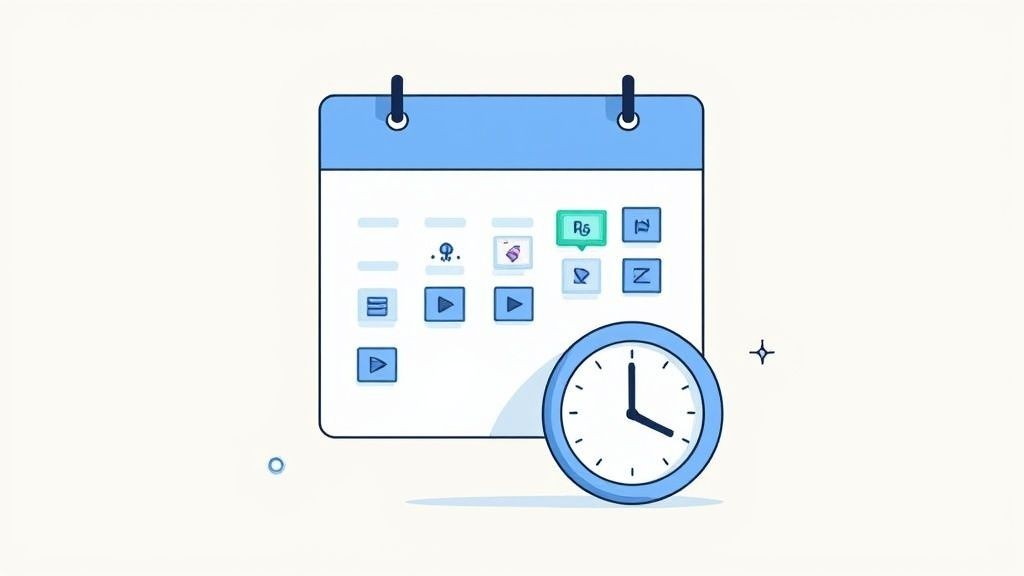
This method was popularized by digital marketing pioneers like Russell Brunson and Amy Porterfield, who use it to scale their course launches and funnel-building systems. The strategy works by combining the urgency and engagement of a live webinar with the efficiency of automation. It creates a system that consistently nurtures prospects and presents your offer to a warm audience, making it one of the most scalable webinar marketing strategies available.
How to Implement This Strategy
- Simulate Live Interaction: To maintain engagement, incorporate interactive elements that mimic a live experience. Pre-load poll questions that appear at specific times and use a simulated chat where you can pre-populate common questions and answers.
- Create Time-Sensitive Offers: Build urgency by including a special offer that is only available to webinar attendees for a limited time. Use countdown timers tied to the individual's viewing session to encourage immediate action.
- Select the Right Technology: Implementing an automated evergreen webinar requires a robust platform. Exploring tools like the GetResponse platform for webinar hosting and automation can significantly enhance your efforts by providing the necessary features for scheduling, interaction simulation, and follow-up sequences.
- Keep Content Fresh: Periodically review and update your webinar content to ensure it remains relevant and accurate. Refreshing statistics, case studies, or examples every few months prevents your evergreen material from becoming stale.
This strategy is perfect for businesses with a proven offer and a high-converting presentation. It’s ideal for selling digital products, online courses, or coaching services, allowing you to generate revenue on autopilot and focus on other areas of your business.
5. Multi-Part Series Strategy
The Multi-Part Series Strategy is a powerful approach that transforms a single webinar into a connected, episodic learning experience. Instead of cramming a complex topic into one session, you break it down into multiple, digestible parts. Each webinar functions as a standalone educational piece while also acting as a trailer for the next, encouraging sustained engagement over weeks or even months.
This method excels at building long-term relationships and establishing deep expertise. By creating an ongoing narrative, you train your audience to anticipate your content and consistently make time for your brand. This is one of the most effective webinar marketing strategies for cultivating a dedicated community and guiding them through a comprehensive learning journey that mirrors a customer lifecycle.
How to Implement This Strategy
- Plan the Entire Arc: Before launching the first session, map out the entire series curriculum. Define the key takeaway for each episode and ensure they logically connect to form a complete, valuable course. A clear beginning, middle, and end is crucial.
- Create Compelling Cliffhangers: End each webinar with a compelling preview of what’s coming next. Pose a challenging question or hint at a powerful solution that will be revealed in the following session to maximize return attendance.
- Build an Exclusive Community: Create a dedicated space like a Slack channel, Facebook Group, or private forum for series attendees. This fosters peer-to-peer discussion, allows for deeper Q&A, and builds a powerful sense of belonging around your brand.
- Offer Completion Incentives: Reward attendees who complete the entire series. This could be a certificate of completion, an exclusive digital badge, or a special discount on your product, providing a tangible incentive to stay engaged until the end.
This strategy is ideal for in-depth educational topics, software onboarding, or corporate training programs. It is a cornerstone tactic for thought leaders like Jeff Walker with his Product Launch Formula, who use sequential content to build immense anticipation and drive massive action.
6. Interactive Workshop and Hands-On Strategy
One of the most engaging webinar marketing strategies is to transform a passive viewing experience into a dynamic, hands-on workshop. The Interactive Workshop and Hands-On Strategy shifts the focus from one-way information delivery to active participation, where attendees learn by doing. Instead of just listening, they engage in real-time exercises, complete assignments, and collaborate on activities.
This approach, championed by coding bootcamps and creative educators like Canva, creates a deeply memorable and effective learning environment. By involving attendees directly, you ensure they internalize the information and can apply it immediately. This transforms your webinar from a simple presentation into a valuable training session, significantly increasing its perceived value and positioning your brand as a practical expert.
How to Implement This Strategy
- Design for Participation: Structure your webinar around specific tasks or exercises. Plan each segment to include an active component, whether it's filling out a template, participating in a poll that shapes the content, or working through a problem set.
- Limit Attendance for Quality: To facilitate genuine interaction, consider limiting the number of attendees. Smaller groups make Q&A sessions, personalized feedback, and breakout room activities more manageable and impactful. High-quality interaction is a key part of this strategy.
- Prepare and Distribute Materials: Create and send all necessary materials, such as worksheets, templates, or data files, to registrants ahead of time. This ensures everyone is prepared to participate fully from the start. Clear instructions are crucial for a smooth experience. You can even use your event registration form templates to collect information that helps you tailor these materials.
- Utilize Breakout Rooms: For larger groups, leverage breakout rooms to foster small-group collaboration. Assign a specific task or discussion topic for each room, then bring everyone back together to share their findings.
This method is ideal for teaching practical skills, from financial planning to software usage or creative design. It excels at converting engaged attendees into loyal customers by providing a tangible demonstration of value and competence.
7. Hybrid Live and Recorded Strategy
One of the most powerful webinar marketing strategies involves blending the energy of a live broadcast with the polish of pre-recorded content. The Hybrid Live and Recorded Strategy uses pre-recorded segments for core presentations, demos, or complex explanations, while leveraging live segments for real-time interaction, Q&A sessions, and personalized engagement. This creates a seamless, professional, and dynamic experience for attendees.
This method, often used by large-scale event organizers and enterprise software companies for major product launches, offers the best of both worlds. It minimizes the risk of technical glitches or presenter errors during crucial parts of the webinar, while maintaining the authentic, interactive connection that makes live events so compelling. You get a flawless core message delivery combined with genuine audience participation.
How to Implement This Strategy
- Segment Your Content: Clearly map out your webinar agenda. Identify the core, unchanging content that can be pre-recorded for a perfect delivery, such as a product demo or a detailed tutorial. Designate sections for live interaction, like the introduction, audience polls, and the final Q&A.
- Create Smooth Transitions: Plan how you will move between live and recorded segments. Use a live host to introduce a recorded video and then return on screen afterward to discuss it. Use on-screen graphics or specific transition slides to signal the change to the audience.
- Test Your Tech Rigorously: The technical execution is critical. Conduct multiple full rehearsals to test your broadcasting software's ability to switch between live camera feeds and video playback. Ensure audio levels are consistent across both formats to avoid a jarring experience for viewers.
- Engage During Recorded Segments: While a pre-recorded video is playing, the host and moderators should be highly active in the chat. Answer questions, respond to comments, and post relevant links. This keeps the audience engaged and reinforces the "live" feel of the event.
This strategy is ideal for high-stakes presentations like major corporate announcements, paid training programs, or detailed software launches where precision is paramount. It allows for a polished, high-production-value presentation without sacrificing the crucial element of live audience interaction.
8. Urgency and Scarcity-Driven Strategy
The Urgency and Scarcity-Driven Strategy leverages powerful psychological triggers to encourage immediate action from attendees. This approach involves creating time-limited offers (urgency) or restricting the availability of a product or bonus (scarcity) to motivate decisive action. It effectively counters prospect procrastination by presenting a compelling reason to buy now rather than later.
Pioneered by direct response marketers like Russell Brunson and Frank Kern, this strategy is highly effective because it taps into the fear of missing out (FOMO). When attendees believe a valuable offer will disappear, they are more likely to make a purchase. The key is to ensure the urgency is genuine and the offer provides immense value, making the quick decision feel both logical and necessary.
How to Implement This Strategy
- Create Genuine Scarcity: Frame your offer with credible limitations. This could be a limited number of "fast-action" bonuses, a cap on enrollment for a coaching program, or a finite number of one-on-one consultation slots available only to webinar attendees.
- Incorporate Visible Urgency Cues: Use on-screen countdown timers during your offer presentation to visually reinforce the deadline. Mention the time limit verbally throughout the pitch to ensure the message is clear and consistently reinforced.
- Justify the Premium Offer: Clearly articulate why the special webinar offer is uniquely valuable. This could be exclusive pricing, bundled products not available elsewhere, or a bonus package that dramatically enhances the core product's value.
- Follow Through on Deadlines: To maintain credibility for future webinars, you must honor your stated deadlines. If you say an offer expires at midnight, ensure it does. This builds trust and trains your audience to act quickly next time.
This method is particularly potent for product launches, course enrollments, and SaaS promotions. It excels at converting highly engaged, bottom-of-funnel leads into immediate customers by providing a powerful incentive that overcomes decision fatigue. For more insights on incorporating these tactics, you can explore tips on email marketing for events.
9. Community Building and Engagement Strategy
Transforming one-off webinar attendees into a dedicated, interactive group is a powerful webinar marketing strategy. The Community Building and Engagement Strategy focuses on nurturing a space where participants connect with your brand and each other, fostering a sense of belonging that encourages repeat attendance and deeper brand loyalty. This turns your webinars from isolated events into cornerstone content for a thriving ecosystem.
Companies like Notion and Slack have mastered this by creating user communities where webinars are central touchpoints for learning and peer support. Instead of marketing to a cold audience for each event, you are inviting members of an established community. This creates a flywheel effect where engaged members become your most effective promoters, driving new sign-ups through genuine word-of-mouth.
How to Implement This Strategy
- Create a Dedicated Hub: Establish a central space for your community to live, such as a private Facebook Group, a dedicated Slack or Discord server, or a forum on your website. This is where pre-webinar discussions and post-event follow-ups will happen.
- Encourage Peer-to-Peer Interaction: Actively facilitate conversations between members. Pose questions, run polls, and create threads where they can share their own experiences and solutions related to the webinar topics.
- Recognize and Reward Members: Publicly acknowledge active participants during webinars or in the community space. Offer exclusive benefits like early access to new content, special Q&A sessions, or unique resources to reward their engagement.
- Host Informal Networking Events: Supplement your formal educational webinars with casual "office hours" or virtual coffee chats. These less structured events are excellent for strengthening personal connections and building rapport.
This strategy is particularly effective for SaaS companies, online course creators, and brands with a strong user base. It excels at improving customer retention and building a loyal following that views your brand as an indispensable part of their professional growth. For more ways to leverage your community, explore these event promotion ideas.
Webinar Marketing Strategies Comparison
| Strategy | Implementation Complexity 🔄 | Resource Requirements ⚡ | Expected Outcomes 📊 | Ideal Use Cases 💡 | Key Advantages ⭐ |
|---|---|---|---|---|---|
| Educational Content First | High - requires deep expertise and prep | Moderate to high - expert time needed | Builds strong trust, thought leadership, loyal audience | Industries needing trust and education | High trust & credibility, higher conversion via value |
| Product Demo & Behind-the-Scenes | Moderate - polished presentation required | Moderate - product readiness & skills | Demonstrates product value clearly, reduces hesitation | SaaS, tech products, features launch | Transparency, real-time objection handling, creates urgency |
| Expert Interview & Panel Discussion | Moderate to high - coordination intensive | Moderate - guest management | Diverse insights, leverages guest audiences | Industry thought leadership, community building | Multi-perspective credibility, reduces host content load |
| Automated Evergreen Webinar | High - initial recording & tech setup | Low after setup - automated delivery | Scalable lead gen, consistent quality, 24/7 availability | Lead generation at scale, passive sales | Highly scalable, time-efficient, consistent messaging |
| Multi-Part Series | High - sequential content & scheduling | High - multiple sessions & follow-up | Deeper engagement, comprehensive learning, loyal audience | Complex topics needing depth | Builds relationships, multiple conversion points |
| Interactive Workshop & Hands-On | High - requires strong facilitation & tech | High - interactive tools, small groups | High engagement, immediate learning, strong community | Skill-building, hands-on training | Higher retention, instant feedback, memorable experiences |
| Hybrid Live and Recorded | Very high - complex production & timing | High - tech, editing & coordination | Balanced engagement & quality, flexible content updates | Corporate training, complex presentations | Professional quality with live authenticity |
| Urgency and Scarcity-Driven | Moderate - requires timing & offer design | Moderate - marketing support | Increased immediate conversions, motivated fast action | Sales-driven webinars aiming for quick decision | Boosts urgency & conversion, reduces procrastination |
| Community Building & Engagement | High - ongoing management & content needed | High - continuous engagement resources | Builds loyalty, recurring attendance, peer learning | Brands focused on long-term relationships | Strong brand loyalty, word-of-mouth, valuable feedback |
Integrating Your Strategy for Maximum Impact
We have explored a comprehensive suite of powerful webinar marketing strategies, moving far beyond generic advice to give you a tactical playbook for 2025. From the value-driven approach of the Educational Content First Strategy to the dynamic engagement of an Interactive Workshop, the key is understanding that these are not mutually exclusive options. The most sophisticated marketing campaigns often blend elements from multiple strategies to create a unique, compelling experience for their audience.
Imagine combining the authority of an Expert Panel Discussion with the long-term value of an Automated Evergreen Webinar. You could host a live, high-impact panel and then repurpose that recording as an automated, on-demand asset that generates leads for months. Similarly, a Multi-Part Series can be enhanced with Community Building tactics, creating a dedicated space for attendees to connect and learn between sessions. This strategic integration transforms individual webinars into a cohesive, high-performance marketing engine.
Unifying Your Efforts for Maximum ROI
The common thread connecting all successful webinar marketing strategies is a relentless focus on the attendee journey. This journey does not begin at the webinar start time or end when the presentation is over. It’s a continuous cycle of promotion, engagement, and follow-up.
- Pre-Webinar: Your goal is to cut through the noise. This means not just securing a registration but ensuring that registration converts into attendance. This is where the gap between interest and action is most profound.
- During the Webinar: Your focus shifts to delivering immense value and fostering interaction. Whether through live Q&A, polls, or workshop activities, engagement is what separates a memorable event from a forgettable monologue.
- Post-Webinar: This is where relationships are solidified. A thoughtful follow-up sequence, tailored to both attendees and no-shows, can dramatically increase conversions, gather crucial feedback, and build brand loyalty.
Ultimately, mastering these concepts elevates your webinars from a simple lead magnet to a cornerstone of your business growth. It's about building a reputation as a trusted authority, creating genuine connections, and delivering experiences that audiences actively seek out. The most effective webinar marketing strategies are not just about broadcasting information; they are about starting conversations and building communities. By meticulously planning each phase and leveraging the right tools to bridge critical gaps, you can ensure your events deliver maximum impact and a measurable return on investment.
Ready to close the gap between registration and attendance? Implement a foundational tool that puts your event directly on your audience's calendar. Discover how Add to Calendar PRO can dramatically reduce no-shows and enhance your entire webinar marketing strategy. Get started today at Add to Calendar PRO.
